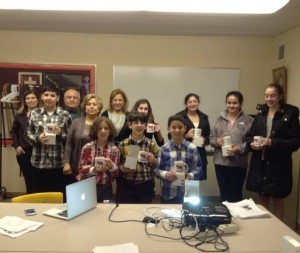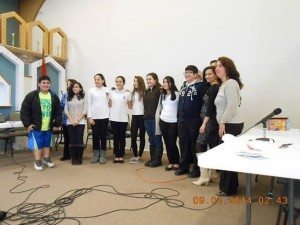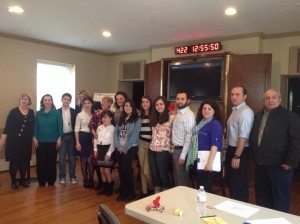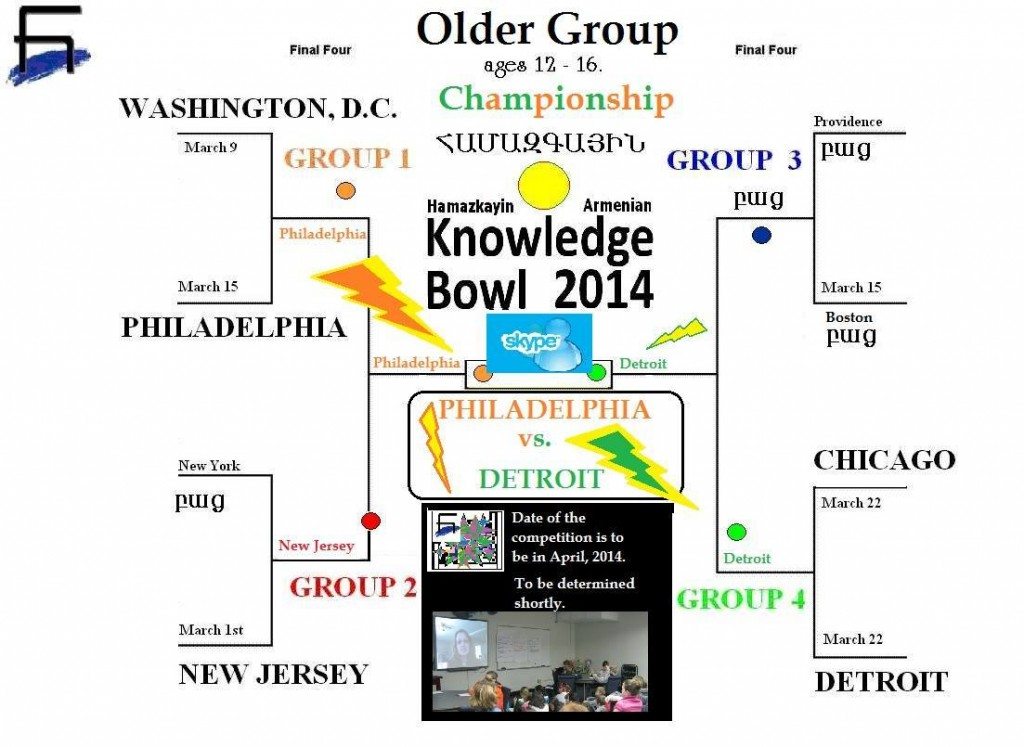Members of the Hamazkayin Armenian Educational and Cultural Organization USA – Eastern Region this year established the “Inaugural Knowledge Bowl competition” (HAKB) to promote Armenian knowledge across its chapters in a friendly, fun but competitive atmosphere, akin to a sports competition, but with no aching joints. Hamazkayin’s “Olympics” was successful insofar as the “best” from each city eventually met to claim victory within an organized regional tournament.

Executive members and liaisons from the Boston, Chicago, Detroit, Philadelphia, Providence New Jersey, New York, and Washington, D.C. Hamazkayin chapters were asked to spread the word and prepare their communities. Thanks to their hard work, diligence, footwork, and inherent interest in “game show”-like knowledge competitions, the Hamazkayin chapters participated with strong interest.
The Knowledge Bowl was inspired by similar competitions held in Armenia and was initially compared to famous game shows in America, such as “Jeopardy,” “Family Feud,” and “Who Wants to be a Millionaire?” The winners would be those who demonstrated the best knowledge of Armenian history and other important Armenian fields, such as art and poetry.
In early 2014, the documents for participants to study and learn—two nicely prepared booklets—were distributed through e-mail and were studied during an unusually long and cold winter.

The Regional Executive transferred the documents to the chapter executive boards, members, and liaisons, who then distributed them to participants.
The Hamazkayin Armenian Knowledge Bowl competition was divided into two groups: a 9-11 junior age group competition and a 12-16 senior age group competition. Prizes were to be given to the top teams. Game rules and a simple paragraph summarizing the essentials of the Knowledge Bowl were provided to all cities along with the question booklets. Each age group participant and his/her parents received the booklet with about 170 carefully selected questions concerning Armenian culture, music, history, and language.

The carefully prepared e-book sized study guide was enthusiastically received. Chicago’s Taniel Varoujan Armenian school staff and students were excited about the HAKB and held a massive local competition one week after its March school-wide spelling bee. No city exceeded Chicago’s live first round competition. The sheer number of participants and emotions from the first-round participating teams flooded the parents and staff with tears of joy and bittersweet defeat. The competition was open to Armenians from any and all other Armenian organizations, and was officially open to non-Armenians who were interested in Armenian history. About 95 percent of the questions were written in both Armenian and English, making it a bilingual document open to all, and a learning tool for Armenian language acquisition.
In Chicago, during the intra-city round, both age groups had 20 students participating in groups of 3 to 4.

It was described as an unprecedented, memorable, festive, and colorful afternoon glamorizing Armenian history and culture. It was a computer and projector-driven, game show-like competition, hosted by Artsrun Ohanian, a computer programmer who emigrated from Armenia just three years ago. All teams were given letter-sized papers with the numbers 1, 2, 3 and 4 written on one side, and the Armenian meg, yergou, yerek, chors in tiny print in Mesrobian script on the other. The rules set forth by Hamazkayin were followed. Each team had a captain and 20 seconds to quietly discuss the answer after the host read the question in both Armenian and English. When he called “Time is up, show your answer!” each team turned over their paper and held it until the three judges identified which had selected the correct answer—and added to the tally on a large whiteboard. Some teams in Chicago fist-pumped and yelled in delight when they got the answer correct, sometimes taking the lead. After three lead changes, the winning team emerged from third place to win in the younger age group. The top and third-place teams were separated by two points in both age groups, causing groans and even quiet tears. “Losing teams” were reminded that as we were all Armenians learning about Armenian history, we were all winners. All participants were deemed winners if they learned even one thing about Armenian history.

Just two weeks later, the world’s first intra-city Armenian knowledge bowl competition was held by means of the world wide web, when Chicago and Detroit met through a Skype connection and used both shared screen technology and a random number generator to select from the approximately 150 multiple choice questions. Artsrun Ohanian was again the host and pressed the questions onto the screen, using his laptop. The Chicago and Detroit teams were nearly tied and tensions ran high as the Skype face-to-face connection turned into an Armenian knowledge battlefield.
Out of more than 60 questions asked, across two age groups, all four teams scored well over 90 percent correct, including open-ended questions where each team was required to write down the answer (and show it when asked by Ohanian). Chicago nearly won because they did better than Detroit on the fill-in-the blank questions, but the Detroit team was essentially perfect in the multiple choice questions in both age groups, and enjoyed a double victory. Detroit’s younger and older age groups went on to face other teams from other cities using the Skype technology, and won again.

The contest was summarized in a competition bracket similar to those used in basketball tournaments, and the results and photographs were posted on the social media Facebook page of Hamazkayin, as well as Chicago’s Hamazkayin webpage.
The idea of the HAKB became a reality of young Armenians spending hours studying Armenian history and culture. Chicago and Detroit, with five hours of driving and the state of Indiana between them, met using technology to deliver a powerful message: Our cities can easily be linked by the internet. The technology should perhaps be used more, for educational lectures, and for other reasons that advance our interconnectivity and vital potential.
The teams that advanced to the quarter finals were the ones who outcompeted the local teams. In some regions it was very fierce.
Results: Ages 9-11
Quarter Finals:
Detroit’s team of Hagop Alajajian, Mardig Alajajian, and Christopher Alajajian (Hamazkayin Detroit) outscored Chicago’s team of Aleen Soulakian, Sona Papazian, Sevana Papazian, and Marianna Alexanian (Taniel Varoujan School).
Washington D.C.’s team of Aryanoush Balian and Sunne Hamparian (Hamasdegh School) outscored Philadelphia’s team of Sona Bardakjian, Kevork Zibary, Narek Boghsian, Sevag Yepoyan, Ani Dardarian, and Rebecca Selverian (Armenian Sisters’ Academy).
New Jersey’s team of Isabelle Emirzian, Alex Vartanian,and Nahreg Rastguelenian (Hamazkayin NJ) advanced over New York.
Boston’s St. Stephen’s School team advanced over Providence.
Semi Finals:
Washington, D.C.’s team outscored New Jersey’s team.
Detroit’s team outscored Boston’s team.
Finals:
Detroit and Washington, D.C. tied and became mutual champions of the Junior Hamazkayin Knowledge Bowl.
D.C. and Detroit had met via Skype and after two tiebreaking rounds, they were still tied. With fatigue setting in, and an emergency telephone consultation by both sides with an advisor from the Regional Executive, it was decided to end the competition in a “double overtime” tie. The two teams quite literally learned the entire Armenian Knowledge Bowl document of questions!
Results: Ages 12-16
Quarter Finals:
Detroit’s team of Nayiri Sagherian, Kegham Jalhaian, Celene Philip, Samantha Patterson, and Nayri Carman (Hamazkayin Detroit) outscored Chicago’s team of Areni Artinian, Alina Dekirmenjian, Suzanna Tomasian, and Ally Devedjian (Taniel Varoujan School).
Philadelphia’s team of Alicia Handian, Apo Handian, and Anie Hovsepian (Haigazian School) outscored Washington, D.C.’s team of Kristine Antanesian, Soiffi Abkarian, and Galy Jackmakjian (Hamasdegh School).
New Jersey’s team of Aleen Takvorian, Lori Samuelian, and Meline Momjian (Hamazkayin NJ) advanced over New York.
Semi Finals:
Philadelphia’s team outscored New Jersey.
Detroit advanced
Finals:
Philadelphia’s team outscored Detroit to win the Savaenior Hamazkayin Knowledge Bowl championship.
All of the competitions were extremely close. The children who participated in this competition were very intelligent and able to absorb a tremendous amount of knowledge about Armenian history and culture quickly.
Chicago, Detroit, New Jersey, Philadelphia, and Washington, D.C. demonstrated above average to outstanding levels of participation. Looking at the eastern region, the Hamazkayin Armenian Knowledge Bowl had an indisputably successful inaugural run. It appears clear that for an educational and cultural organization, philosophically, this was a wildly successful inaugural run. Thanks go to the participants in the participating Armenian communities across the eastern United States. Without them, the Hamazkayin Knowledge Bowl document would have remained just that, an electronic document without life, without contestants, and without enthusiastic readers. The best news of all is that next year’s Armenian Knowledge Bowl will be better. Each community has experts on how to accomplish Skype conferences. The miles that separate us shall be the length of the ties that bind us.




Be the first to comment